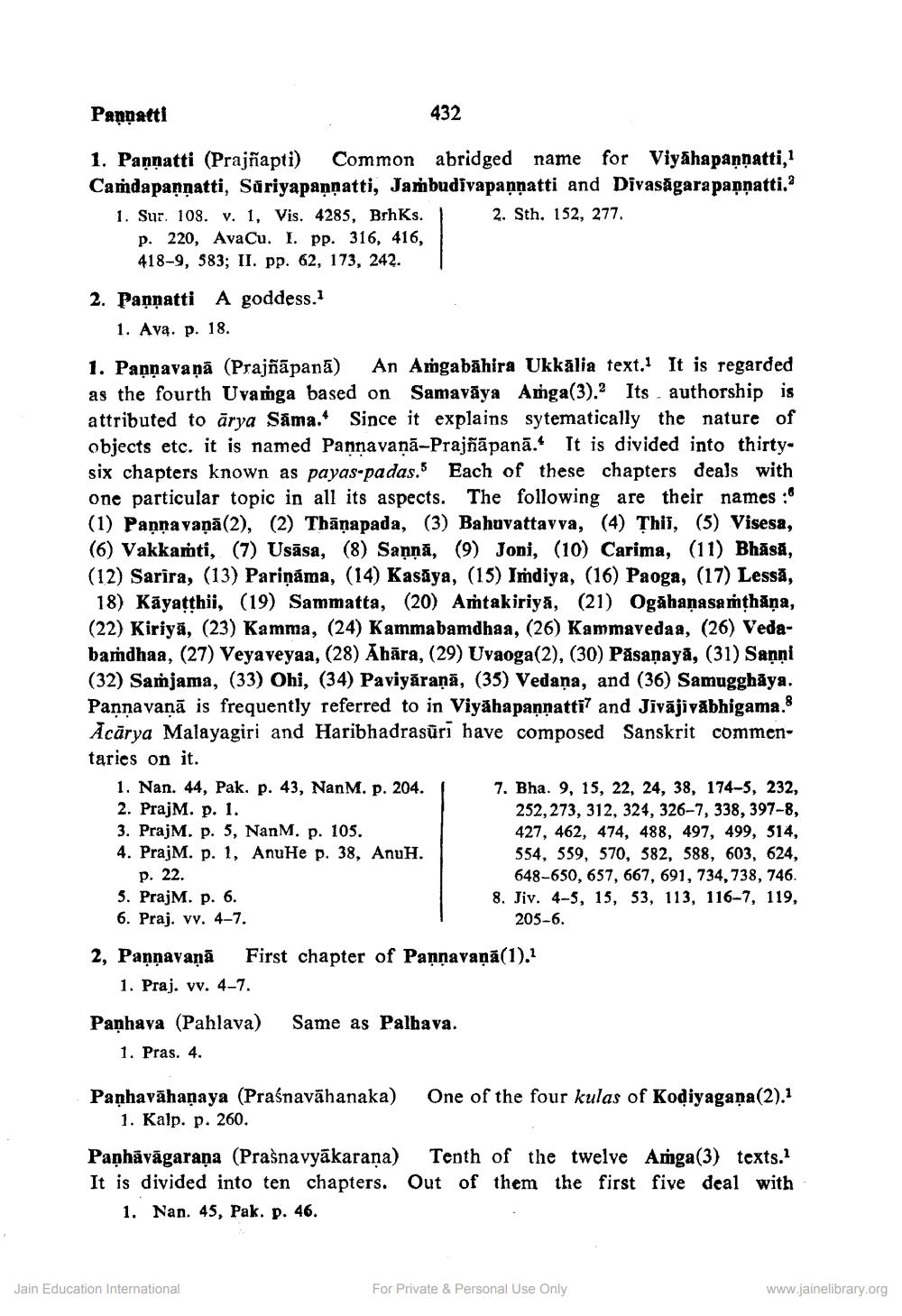________________
Pappatti
1. Pannatti (Prajñapti) Common abridged name for Viyahapaṇṇatti,1 Camdapanṇatti, Suriyapanṇatti, Jambudivapannatti and Divasagarapaṇṇatti."
2. Sth. 152, 277.
1. Sur. 108. v. 1, Vis. 4285, BrhKs.
p. 220, AvaCu. I. pp. 316, 416, 418-9, 583; II. pp. 62, 173, 242.
2. Pannatti A goddess.1
1. Avą. p. 18.
1. Pannavaṇā (Prajñāpanā) An Amgabahira Ukkālia text. It is regarded as the fourth Uvamga based on Samavaya Amga(3). Its authorship is attributed to arya Sama. Since it explains sytematically the nature of objects etc. it is named Pannavaṇā-Prajñāpanā. It is divided into thirtysix chapters known as payas-padas. Each of these chapters deals with one particular topic in all its aspects. The following are their names:" (1) Panṇavana(2), (2) Thāṇapada, (3) Bahuvattavva, (4) Thii, (5) Visesa, (6) Vakkamti, (7) Usāsa, (8) Sanna, (9) Joni, (10) Carima, (11) Bhāsā, (12) Sarira, (13) Pariņāma, (14) Kasaya, (15) Iṁdiya, (16) Paoga, (17) Lessă, 18) Kayatthii, (19) Sammatta, (20) Amtakiriya, (21) Ogāhaṇasaṁṭhāṇa, (22) Kiriyā, (23) Kamma, (24) Kammabamdhaa, (26) Kammavedaa, (26) Vedabamdhaa, (27) Veyaveyaa, (28) Ahāra, (29) Uvaoga(2), (30) Pāsaṇayā, (31) Saņņi (32) Samjama, (33) Ohi, (34) Paviyāraṇā, (35) Vedana, and (36) Samugghāya. Pannavana is frequently referred to in Viyahapannatti' and Jivājivābhigama.8 Acarya Malayagiri and Haribhadrasuri have composed Sanskrit commentaries on it.
1. Nan. 44, Pak. p. 43, NanM. p. 204. 2. PrajM. p. 1.
3. PrajM. p. 5, NanM. p. 105.
4. PrajM. p. 1, AnuHe p. 38, AnuH.
p. 22.
5. PrajM. p. 6.
6. Praj. vv. 4-7.
2, Paṇṇavaṇā
1. Praj. vv. 4-7.
432
Panhava (Pahlava)
1. Pras. 4.
First chapter of Pannavaṇā(1).1
Jain Education International
Same as Palhava.
Panhavahaṇaya (Praśnavahanaka) 1. Kalp. p. 260.
7. Bha. 9, 15, 22, 24, 38, 174-5, 232, 252,273, 312, 324, 326-7, 338, 397-8, 427, 462, 474, 488, 497, 499, 514, 554, 559, 570, 582, 588, 603, 624, 648-650, 657, 667, 691, 734,738, 746. 8. Jiv. 4-5, 15, 53, 113, 116-7, 119, 205-6.
One of the four kulas of Kodiyagaṇa(2).1
Tenth of the twelve Amga(3) texts.1
Paṇhāvāgaraṇa (Prasnavyakarana) It is divided into ten chapters. Out of them the first five deal with
1. Nan. 45, Pak. p. 46.
For Private & Personal Use Only
www.jainelibrary.org




